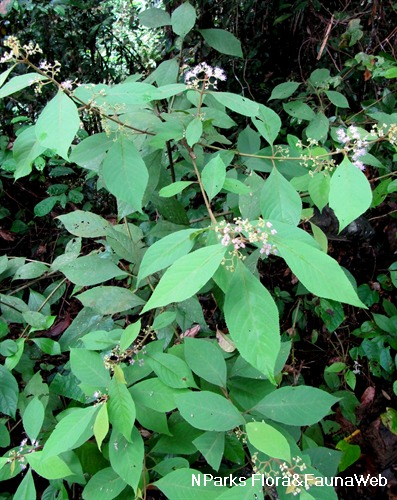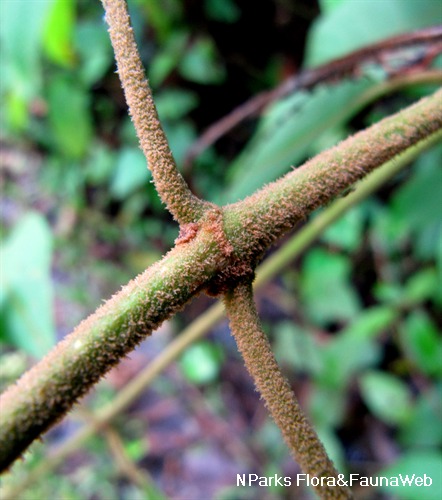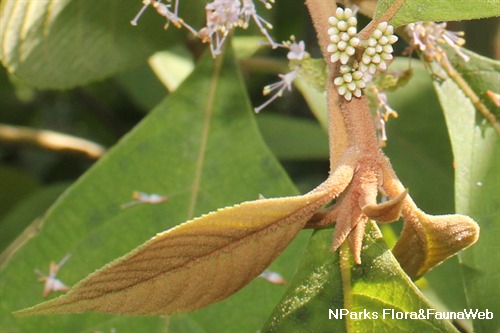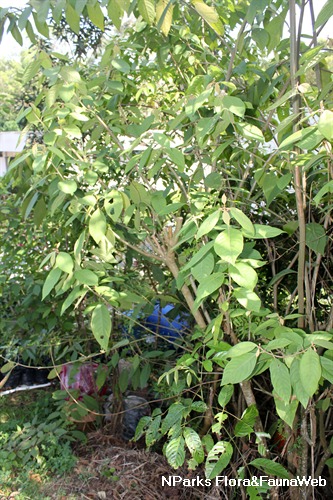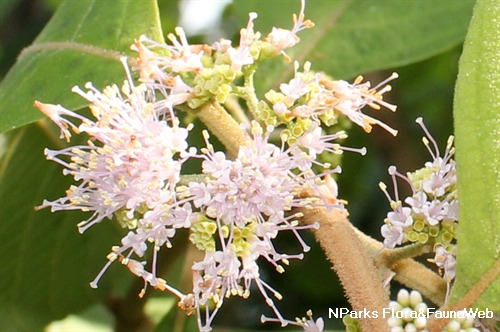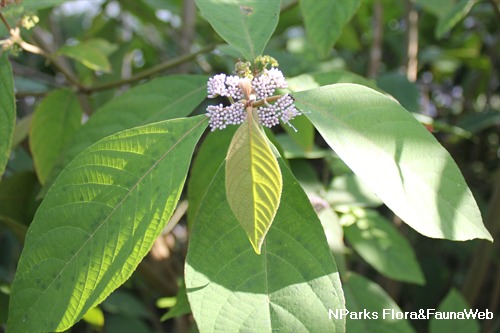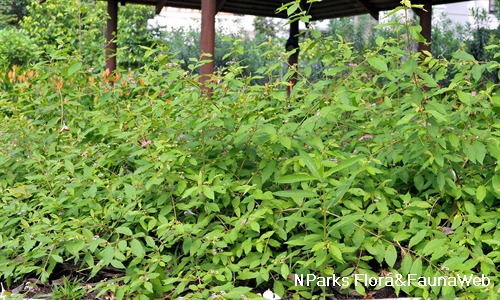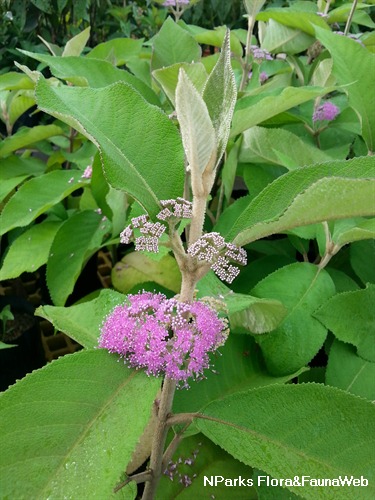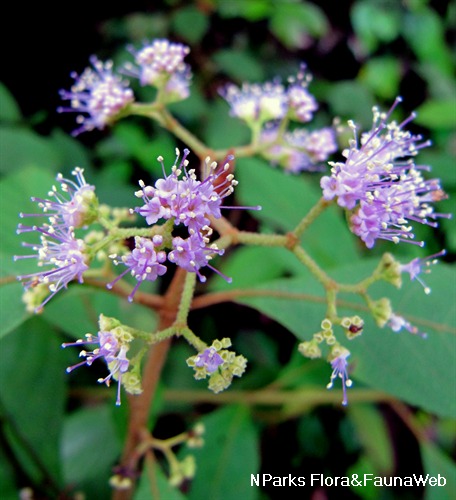
Back
Callicarpa longifolia Lam.
| Family Name: | Lamiaceae (Labiatae) |
| Common Name: | Long Leaved Beauty Berry, Nasi-nasi, White-berried Malayan Lilac, Capal, Capal Kecil, Karat Besi, Tampah Besi, Tampal Besi, Tampung Besi, Tampung Besi Putih, 长叶紫珠 |
Name
Classifications and Characteristics
| Plant Division | Angiosperms (Flowering Seed Plants) (Dicotyledon) |
|---|---|
| Plant Growth Form | Shrub |
| Lifespan (in Singapore) | Perennial |
| Mode of Nutrition | Autotrophic |
| Plant Shape | Irregular |
| Maximum Height | 2 m to 5 m |
Biogeography
| Native Distribution | Southern China, southern Thailand through Malaysia, Singapore, the Philippines, Brunei, Indonesia to Papua New Guinea, and Australia |
|---|---|
| Native Habitat | Terrestrial (Secondary Rainforest, Disturbed Area / Open Ground) |
| Preferred Climate Zone | Tropical, Sub-Tropical / Monsoonal |
| Local Conservation Status | Native to Singapore (Vulnerable (VU)) |
Description and Ethnobotany
| Growth Form | It is a shrub up to 5 m tall. The young vegetative parts are covered with brownish or brownish-white, flake-like hairs. |
|---|---|
| Foliage | Its opposite, stalked leaves have leaf blades that are usually elliptic, pointed, and 7.6–20 by 2–8.9 cm. The leaf blades are nearly not covered with hair below, or thinly covered with flake-like scales. |
| Flowers | Its tiny, 4-petaled flowers are about 2 mm long, pink or pale lilac and borne on a 2–3 cm wide cluster. |
| Fruit | Its fleshy fruits (2-6 mm long, 2-6 mm wide) are covered in minute hairs and yellow glands, ripening to white or cream-colour. Each fruit contains 1-4 seeds. |
| Habitat | It grows along mountain roads and in open country. |
| Associated Fauna | Its flowers are insect-pollinated. Its fruits are eaten by birds. |
| Cultivation | It can be propagated by seed or stem cutting. |
| Etymology | Greek kalli, beautiful; Greek karpos, fruit; Latin longifolius, long-leaved |
| Ethnobotanical Uses | Medicinal: According to folk medicine, the roots are effective against stomachache, diarrhoea and syphilis. Its leaves are widely used for poulticing and for rubbing over the body in fever, and are also applied to swellings. A decoction of the leaves is drunk in colic, after parturition and for fever. An infusion of the roots is mentioned as a remedy for syphilis. Various parts, prepared in different ways, are prescribed as a remedy for sprue. Pounded leaves are an ingredient for a poultice to mature boils and ulcers. An infusion of the leaves is drunk as a depurative after parturition. Pounded leaves are used to stupefy fish. In East New Britain, the leaves are externally applied on wounds to an ulcerated mouth and to reduce fever, swellings and bruises. The leaves or roots are internally applied to treat diarrhoea. Others: Fishes can be stunned by pounded leaves added to the water. |
Landscaping Features
| Landscaping | It is suitable for parks for its attractive flowers. |
|---|---|
| Desirable Plant Features | Ornamental Flowers, Ornamental Fruits |
| Landscape Uses | Parks & Gardens, Small Gardens |
Fauna, Pollination and Dispersal
| Fauna Pollination Dispersal Associated Fauna | Bird-Attracting, Butterfly-Attracting |
|---|---|
| Pollination Method(s) | Biotic (Fauna) |
| Seed or Spore Dispersal | Biotic (Fauna) |
Plant Care and Propagation
| Light Preference | Full Sun |
|---|---|
| Water Preference | Moderate Water |
| Rootzone Tolerance | Moist Soils, Well-Drained Soils, Fertile Loamy Soils |
| Propagation Method | Seed, Stem Cutting |
Foliar
| Foliage Retention | Evergreen |
|---|---|
| Mature Foliage Colour(s) | Green |
| Mature Foliage Texture(s) | Scaly |
| Prominent Young Flush Colour(s) | Brown |
| Young Flush Texture(s) | Scaly |
| Foliar Type | Simple / Unifoliate |
| Foliar Arrangement Along Stem | Opposite |
| Foliar Attachment to Stem | Petiolate |
| Foliar Shape(s) | Non-Palm Foliage (Elliptical) |
| Foliar Venation | Pinnate / Net |
| Foliar Margin | Entire - Wavy / Undulate, Serrate / Toothed |
| Foliar Apex - Tip | Acuminate |
| Foliar Base | Cuneate |
Floral (Angiosperm)
| Flower & Plant Sexuality | Bisexual Flowers |
| Flower Colour(s) | Pink, Purple |
|---|---|
| Flower Grouping | Cluster / Inflorescence |
| Flower Location | Axillary |
| Flower Symmetry | Radial |
| Individual Flower Shape | Campaulate / Bell-shaped |
| Inflorescence Type | Cyme |
Fruit, Seed and Spore
| Mature Fruit Colour(s) | Cream / Off-White, White |
|---|---|
| Mature Fruit Texture(s) | Smooth |
| Fruit Classification | Simple Fruit |
| Fruit Type |
Image Repository
Others
| Master ID | 31181 |
|---|---|
| Species ID | 5575 |
| Flora Disclaimer | The information in this website has been compiled from reliable sources, such as reference works on medicinal plants. It is not a substitute for medical advice or treatment and NParks does not purport to provide any medical advice. Readers should always consult his/her physician before using or consuming a plant for medicinal purposes. |

